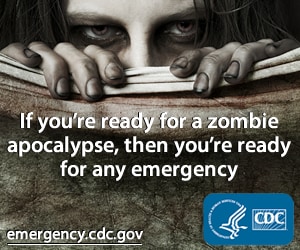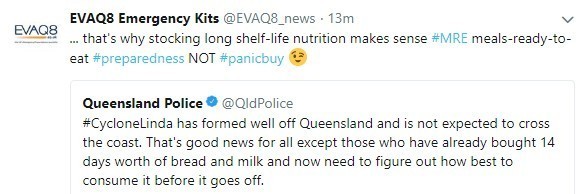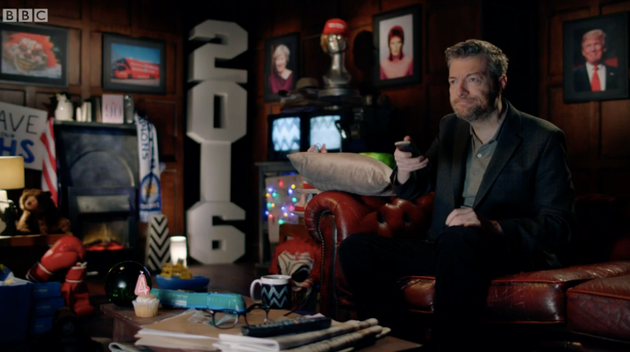One way of engaging with emergency preparedness is to create an ABC. It’s a fun activity for adults and kids alike to get thinking about the important topic of how to be better prepared for an emergency or disaster, what that entails and means. Here is one such ABC of emergency preparedness, focusing on household preparedness and family in a general setting. Examples are drawn internationally because the same fundamental preparedness principles apply irrespective of where in the world you are. I hope what follows will inspire you to come up with your own version of your ‘personal’ ABC of Emergency Preparedness. [this post is also accessed by bit.ly/preparednessABC]
A for ATTITUDE | ABC of Emergency Preparedness
No matter what kind of emergency, staying calm and keeping a positive attitude is essential. Do not panic. Get your breathing under control to clear your mind so that you can assess the situation appropriately.
Connected to attitude are beliefs and here drawing on faith for strength is useful irrespective of exactly what kind of ideology you follow. In addition, check out the post on how to achieve realistic confidence in the face of crisis.
B for BE BETTER PREPARED | ABC of Emergency Preparedness
That means being PRO-ACTIVE rather than just re-active. Planning ahead, getting equipped and informed is your best bet. Preparedness means you are likely to better manage in an emergency or disaster. Up your chances by upping your capacities (kit, supplies, tools etc.) and capabilities (knowledge, training, skills etc).
C for COMMUNICATE | ABC of Emergency Preparedness
Emergency preparedness is a ‘group sport’ so to be able to communicate effectively before, during and after a crisis is vital. The word ‘preparedness’ implies being better prepared BEFORE something happens. Planning your communication is as important as communicating during your planning stage: it sets everything up and keeps everything going. That also means when you make your household emergency plan, check your assumptions: don’t just think you know but find out, update and verify, talk to reliable people in your communities as well as emergency planning professionals such as via your Local Resilience Forum. In addition, keep in mind that communication is more than just giving and following advice or instructions and staying in touch. It’s also about signalling for help, coordinating emergency plans beyond immediate family to other groups of people, locating the missing or lost, organising support and new supply chains etc. Some questions to explore include where do you find the right information? How and what do you communicate to your loved ones when you’re setting up your plan? What does communication look like during a crisis and in the aftermath in how to receive help or in how to assist? How can you communicate effectively under potentially extreme situations? What will you need to be more self-reliant?
D for DEVICES | ABC of Emergency Preparedness
Tech is great – when it works. Problem is it often doesn’t during a real crisis or disaster situation. No power, limited battery life, network failures… in short, you need additional kit as well as independent low-tech solutions. Good examples here are solar chargers for your gadgets, hard copies of local maps as well as your ID’s and insurance documents, pocket guides for first aid and survival etc.
E for EVACUATION | ABC of Emergency Preparedness
Do you stay or go? In some situations the best option is safe evacuation, getting out of harm’s way quickly, returning once the all clear has been given by authorities. Evacuation can happen for many reasons and can be temporary, lasting just a few minutes or hours or expand to more medium or even long term shelter-in-place situations away from your home. Most evacuations are self-evacuations when you get right down to it. So what exactly does safe self-evacuation look like?
F for FIRST AID | ABC of Emergency Preparedness
First aid is an essential life skill and the more training and knowledge you have the better off you are in an emergency situation. It’s that simple. However, it’s no good knowing a lot and then not having the tools and resources when and where you need them so a well-stocked first aid kit or medical kit is an absolute must, kitted to your abilities and needs.
G for GO-BAG | ABC of Emergency Preparedness
All essentials packed in one sturdy grab bag ready to go at any time, that’s a GoBag. Find out how to build your own emergency kit and check out our preparedness hub for even more free resources.
H for HYGIENE | ABC of Emergency Preparedness
Hygiene contributes to health. Absence or insufficient hygiene in the aftermath of a disaster can have very serious consequences. Water purification is an important element as is travel hygiene, i.e. during an evacuation and shelter-in-place situation.
I for IDENTIFICATION | ABC of Emergency Preparedness
Your GoBag must contain paper copies of documents that can prove your identity and address as a minimum. Additional documents and USB backups of i.e. personal photos, contacts list, insurance, inventory accounts etc. are highly recommended.
J for JUNK | ABC of Emergency Preparedness
Everything but the kitchen sink, it might come in useful. No! Leave unnecessary items behind. Make the right choices in what to take with you and how to secure the belongings you leave behind. Your GoBag must be comprehensive enough to last you 72 hours yet must be light enough that you can carry it comfortable for extended periods of time. Loading up your car with tons of stuff does not mean you are better prepared. Less is more. Get the right kit; don’t simply make do. Your life may depend on it. And whatever you do, NEVER leave your pets behind!
K for KEEP FOCUSED | ABC of Emergency Preparedness
Emergencies or disaster can be confusing and scary. Understanding fear is important as it can be your best ally. What do you need to help you keep focused and maintain a positive attitude? Short-term energy food and drinks help as well as frequent morale boost. What works for you and how will you build this into your emergency plan to be better prepared?
L for LOCAL MAPS | ABC of Emergency Preparedness
Having accurate information about your local environment is key: roads, bridges, rivers, lakes, woods, towns etc. Don’t rely on tech alone which may stop functioning in an emergency or disaster. Know several ways to get to safe shelter locations. Also, knowing about your flood and other risks based on local maps is crucial.
M for MEALS-READY-TO-EAT aka MRE | ABC of Emergency Preparedness
If your car runs out of fuel, it stops and if YOU run out of fuel so will you. Maintaining energy levels during a crisis means that you can continue doing what you need to be doing. The last thing you want to worry is about cooking your next decent meal. MRE’s have been used by the military for many years and there are many reasons why they work so well for emergency preparedness: delicious, nutritious, long-shelf life, space and cost effective. So, check it out and also see our survival food page. What’s your favourite menu?
N for NOURISHMENT | ABC of Emergency Preparedness
Quality emergency and survival food is one aspect but there is also mental and emotional nourishment. As mentioned earlier, maintaining attitude and the ability to keep focus is crucial to being better prepared for emergencies. Once the initial urgent phase has passed there needs to be time to process, coming to terms with events and finding silver linings, giving and finding support on all levels: physical, mental and emotional – perhaps sometimes using ‘unusual’ tools ;-) ….
O for ORGANISE | ABC of Emergency Preparedness
Without ‘organising’ you are toast in an emergency or disaster situation, it’s that simple. Get cracking, it’s easy and even fun to do so. Make emergency preparedness plans for work and private life: a personal emergency plan, a family emergency plan, a community emergency plan, a fire safety plan, an evacuation plan, a shelter-in-place plan, a travel emergency plan ….any and all that make sense and are needed in your particular sets of circumstances. To start, head over to our emergency preparedness hub with lots of free resources and downloads.
P for PETS | ABC of Emergency Preparedness
Leave no one behind in an emergency or disaster and this also goes for your pets or animals. We have a special page for Emergency Preparedness with Pets so head right over.
Q for QUESTIONS | ABC of Emergency Preparedness
Never stop asking questions about emergency planning and emergency preparedness. Update and upgrade your knowledge, organise and be better prepared. Be selective in the resources you trust – there is a lot of information out there and not everything is good and valid. Local is massively important so a dig through the history of your area for clues of past major incidents is a good idea as is finding out information from your Local Resilience Forum and other trustworthy specialists.
R for RELOCATION POINT | ABC of Emergency Preparedness
Where will you go if you have to evacuate? Not just an assembly point but an alternative safe location in a more medium-term or perhaps longer term where you can find shelter and support. What do you know about evacuation shelters near where you live or work? Are there any and how well equipped are they?What are your self-reliance options? Check out the post on mass evacuation.
S for SAFETY | ABC of Emergency Preparedness
Always think safety first. Don’t take unnecessary risks. This is especially important in a family or small group settings that have to rely on all members. Stay alert during emergencies and always be aware of your surroundings, watching out for potential dangers. Know the difference between risk and hazards. What are likely sources of risks and hazards and how do you plan to deal with them? It’s all part of your emergency plan.
T for TRAVEL | ABC of Emergency Preparedness
Travel may become necessary before or in the aftermath of a disaster. Know your relocation point and how you will get there. Have your GoBag and other supplies ready. Be organised and be better prepared, have a positive attitude and keep focused. As part of your emergency preparedness plans, create checklists of items, streamline necessities and avoid junk. If you travel by car, always carry a Car Emergency Kit in addition to your other supplies.
U for UNSURE | ABC of Emergency Preparedness
Unsure about something? Doubt is excellent for it represents an open door, an opportunity to find out the right information from the right sources. Investigate, never stop asking questions when it comes to emergency preparedness. Continue to upgrade and update your knowledge every day. Preparedness becomes simply part of who you are.
V for VARIOUS NEEDS | ABC of Emergency Preparedness
Children at different ages have different needs from young adults, the middle aged or seniors so you will have to think carefully what capacities and capabilities your emergency preparedness has to cover under which circumstances. It’s not as daunting as it sounds, however. There is already a lot you know and much you have and can do. Visit our preparedness hub for resources and downloads and get started.
W for WEATHER | ABC of Emergency Preparedness
Being weather aware means you will see it coming and can plan and act accordingly. Early warning systems are pretty good these days for major weather events depending on where in the world you are. Simply keeping an eye on the news or your favourite weather app will keep you in the loop. In addition, include diverse weather (not just severe storms) in your safe evacuation scenarios for it’s an entirely different matter in midsummer heat, deep winter snow freeze or during heavy rains or storms.
X for Xerox copy | ABC of Emergency Preparedness
Vital information such as IDs, insurance, inventories, accounts etc. should always have one or several hard copies in safe places as well as digital backups.
Y for YOU CAN DO THIS! | ABC of Emergency Preparedness
If you feel you are becoming overwhelmed remind yourself that you are capable of doing extraordinary things. Focus on the next minute, the next five, the next hour and just keep going. Most importantly BE PREPARED! Join the race where everyone wins:
… and finally …..
Z for ZOMBIE APOCALYPSE | ABC of Emergency Preparedness
Yes, you heard right! The joke goes that if you are better prepared for a ‘zombie apocalypse’ then you are pretty much prepared for anything.

If it takes that kind of Hollywood fantasy to create interest in emergency preparedness then why not? Let’s go for it. After all, this particular notion even exercises serious scientists who study how disease spreads. Take a look yourself and have a go at ‘Zombietown’ a disease dynamics simulation by physicists Alexander Alemi, Matthew Bierbaum, Christopher Myers and James Sethna of Cornell University and take a look at Leicester University or get stuck in with the CDC:
I hope you enjoyed this ABC of Emergency Preparedness. Happy Easter and good luck with your personal plans for being better prepared.
Monika
For more Resilience Blog simply use the right hand navigation. For emergency kits and practical resources use the top navigation. For more on Emergency+Disaster Preparedness head over to our FREE resources at the Preparedness Hub and find out why we use humour. If you like this post, please share it to help raise awareness for Emergency and Disaster Preparedness. Thank you!
thank you for sharing!
For more EVAQ8 blog simply use the right hand navigation. For emergency kits and practical resources use the top navigation. For FREE resources head over to our Preparedness Hub and find out why we use humour. If you like this post, please share it to help raise awareness for Emergency and Disaster Preparedness. Thank you!
Find EVAQ8 on social media, like and follow us!







































 And I’m being entirely practical, not sarcastic (and truthful) like the
And I’m being entirely practical, not sarcastic (and truthful) like the  It aims to be a guide for ‘Public Immediate Actions for multiple casualties from shooting, stabbing or a bombing’. In other words, a practical extension for everyone and following on from last year’s ‘run, tell, hide’ campaign by the government. For more on that see “
It aims to be a guide for ‘Public Immediate Actions for multiple casualties from shooting, stabbing or a bombing’. In other words, a practical extension for everyone and following on from last year’s ‘run, tell, hide’ campaign by the government. For more on that see “

 Have a great week and good start to September – make it a Preparedness month for yourself, your loved ones and your wider communities. And if you want to delve a little deeper, watch this brilliant VIDEO by The Royal Society, an animation and briefing on unconscious bias adapted by Professor Uta Frith
Have a great week and good start to September – make it a Preparedness month for yourself, your loved ones and your wider communities. And if you want to delve a little deeper, watch this brilliant VIDEO by The Royal Society, an animation and briefing on unconscious bias adapted by Professor Uta Frith 
 The ‘why’ is easy: it’s the law. Since 2004 under the Civil Contingency’s Act, Category 1 responders have a duty to
The ‘why’ is easy: it’s the law. Since 2004 under the Civil Contingency’s Act, Category 1 responders have a duty to  What I particularly like is the focus on capability. It implies inherent and latent capacities. It also ties neatly to preparedness which is not just about needs and liabilities but also about assets. In my view this creates an empowering shift and starting point to mobilize engagement which, given the right momentum, may overcome even learnt helplessness and apathy. Thus
What I particularly like is the focus on capability. It implies inherent and latent capacities. It also ties neatly to preparedness which is not just about needs and liabilities but also about assets. In my view this creates an empowering shift and starting point to mobilize engagement which, given the right momentum, may overcome even learnt helplessness and apathy. Thus

 t more complex than can be crammed into a single blog post. You must consider other important questions related to physical fitness such as: is it best for you to exercise alone or with others (or a bit of both), should you hire a trainer so that you can learn proper exercise technique and what about cross-training, combining exercises of multiple disciplines?
t more complex than can be crammed into a single blog post. You must consider other important questions related to physical fitness such as: is it best for you to exercise alone or with others (or a bit of both), should you hire a trainer so that you can learn proper exercise technique and what about cross-training, combining exercises of multiple disciplines? How about you? Where do you draw your role models from?
How about you? Where do you draw your role models from? Imagination and imitation are powerful forms of learning and shape human behaviour. Throughout our lives we learn by imitating the patterns of thought and behaviour of those around us. Often we are completely unaware that we are doing such observational learning. It is not taught. Rather we simply pick it up merely by being exposed to others and the need to belong and fit in.
Imagination and imitation are powerful forms of learning and shape human behaviour. Throughout our lives we learn by imitating the patterns of thought and behaviour of those around us. Often we are completely unaware that we are doing such observational learning. It is not taught. Rather we simply pick it up merely by being exposed to others and the need to belong and fit in.

